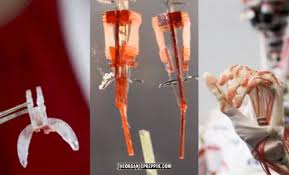
Breaking News
 Tchaikovsky's Swan Lake Just Played On Russia's Doomsday Shortwave Radio Station
Tchaikovsky's Swan Lake Just Played On Russia's Doomsday Shortwave Radio Station
 Michael 'Big Short' Burry Reveals He "Is Not Short" Tesla
Michael 'Big Short' Burry Reveals He "Is Not Short" Tesla
 Why Disney Can No Longer Make Fairy Tales
Why Disney Can No Longer Make Fairy Tales
 Man Achieves American Dream Of Working Hard And Paying Taxes For 50 Years So He Can Fund...
Man Achieves American Dream Of Working Hard And Paying Taxes For 50 Years So He Can Fund...
Top Tech News
 Laser weapons go mobile on US Army small vehicles
Laser weapons go mobile on US Army small vehicles
 EngineAI T800: Born to Disrupt! #EngineAI #robotics #newtechnology #newproduct
EngineAI T800: Born to Disrupt! #EngineAI #robotics #newtechnology #newproduct
 This Silicon Anode Breakthrough Could Mark A Turning Point For EV Batteries [Update]
This Silicon Anode Breakthrough Could Mark A Turning Point For EV Batteries [Update]
 Travel gadget promises to dry and iron your clothes – totally hands-free
Travel gadget promises to dry and iron your clothes – totally hands-free
 Perfect Aircrete, Kitchen Ingredients.
Perfect Aircrete, Kitchen Ingredients.
 Futuristic pixel-raising display lets you feel what's onscreen
Futuristic pixel-raising display lets you feel what's onscreen
 Cutting-Edge Facility Generates Pure Water and Hydrogen Fuel from Seawater for Mere Pennies
Cutting-Edge Facility Generates Pure Water and Hydrogen Fuel from Seawater for Mere Pennies
 This tiny dev board is packed with features for ambitious makers
This tiny dev board is packed with features for ambitious makers
 Scientists Discover Gel to Regrow Tooth Enamel
Scientists Discover Gel to Regrow Tooth Enamel
 Vitamin C and Dandelion Root Killing Cancer Cells -- as Former CDC Director Calls for COVID-19...
Vitamin C and Dandelion Root Killing Cancer Cells -- as Former CDC Director Calls for COVID-19...
Scientists Have Created Programmable Robots Made of LIVING TISSUE. What Could Possibly Go Wrong?

Everyone knows that robots aren't living beings right? Well, we did. That is, until scientists and developers recently announced how they have bridged some of that gap between living and non-living beings.
This new development is a combination of artificial intelligence and biology. In fact, only this week, a research of roboticists and scientists published what is being referred to as a "recipe for making a new lifeform" called xenobots. The xenobots are made from stem cells and the term xeno comes from the frog cells (xenopus laevis) which are used to make them.
One of the researchers involved described the new creation as "neither a traditional robot nor a known species of animal" but instead it is a "new class of artifact: a living, programmable organism."
File this under "What Could Possibly Go Wrong?"
What is a xenobot?
The xenobots are less than 1mm long and are contain 500-1000 living cells. They have a number of shapes, mostly simplistic with some having squat "legs." They are able to propel themselves in linear or circular directions, move small objects, and join together to act collectively. They are able to live up to ten days using their own cellular energy.
Scientists claim that these new "reconfigurable biomachines" can improve human and animal health, but there are many concerns from legal and ethical standpoints.



